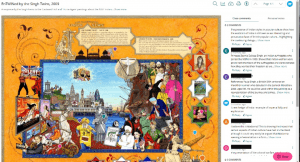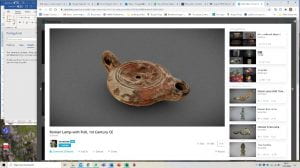In the next in our series of #PandemicPedagogy posts, Leonie Hannan (Queen’s University Belfast @leoniehannan) and Sarah Longair (University of Lincoln, @sclongair) – authors of History through Material Culture (Manchester University Press, 2017) – discuss the challenges of teaching History through material culture online.
In March of this year, from one day to the next, universities across the world dropped long-established patterns of teaching and learning to meet the strange circumstances of a global pandemic. Historians of all stripes worked fast to find new ways of sharing and discussing topics, literatures and primary sources with their students. The rapid transfer to online learning, presented numerous technological and pedagogical challenges, none more so than for those of us teaching history through material culture. Whilst the global crisis offered an opportunity to radically re-think the way we teach, it also delivered caring responsibilities, home-schooling and serious illness to many academics – making normal working life impossible and squashing the space and time required for our best work. However, as the immediacy of lockdown eases and we move into a much-changed teaching environment in the longer term, making the time for reflection and ensuring that we are able to test new methods, with the possibility of failure, is more crucial than ever.
The most significant difficulty posed by our new circumstances is the distance that is placed between ourselves and our primary sources. Despite the transformation of digital resources in recent decades, many historians both need and want to work with manuscripts, artefacts and buildings in person, in the flesh. As historians of material culture, we have regularly extolled the virtues of handling objects – a process we believe can unlock their meanings and change our interpretations of a past almost exclusively understood through text. Of course, we cannot always have objects in the classroom when we teach, and we often rely on museum websites and other sources to explore this subject with our students. Nonetheless, transferring object-led history into an online learning environment was yet another way in which we had to adapt rapidly. We had to try to engage our students in understanding the significance of the material world at a time when so many aspects of our lives became virtual. Here, we will reflect on some examples of online learning through material culture and some of the opportunities and challenges encountered.
In a Level 3 (3rd year undergraduate) module that Sarah teaches on ‘Objects of Empire: Material Worlds of British Colonialism’, there was an established seminar model of students researching and presenting objects they had located on a particular theme and this structure transferred well to the online environment. As has been noted by others elsewhere, the online seminar rooms and chat functions often brought students who had been quieter in the classroom into more active participation. After a group of three students had presented their objects, the group were then shown the three objects together on a single slide and asked to consider connections between them. This strategy worked effectively as they drew out both visual and ideological links as well as bringing the whole class into the discussion. In preparation for another class, the Talis Elevate annotation tool was used which enables students to add comments and questions to sources, including text and images. After uploading the Singh Twins EnTWINed painting, students were invited to analyse the figures, events and language to which the artists were referring.
Image: The Singh Twins EnTWINed painting in Talis Elevate (Sarah Longair)
This painting drew on numerous topics we had studied in the module as well as contemporary figures, so students had to undertake close observation of the image as well as conducting research to unpick all the numerous messages of the painting. They could then drop pins on the point they wished to comment upon and so alongside the image we had a series of discussion points for our seminar. In terms of planning, this tool is ideal for asynchronous activities and provides a student discussion space which can then inform seminar themes. It also enhances students’ skills of observation and annotation of images. This painting was chosen because it is particularly rich in detail which, with a class of 22 students adding comments, is critical.
Another Lincoln module where we had to adapt our teaching and assessment quickly was the Level 2 (2nd year UG) module ‘Material Histories: Objects, Display and Analysis’ which took place in our Conservation labs and used teaching collection objects for seminars and assessments. The second assessment preparation took place just after lockdown started and, as a close object description, had to be rethought. Here, my colleague Jim Cheshire, decided that we could reconfigure the assessment by asking students to study objects on the Sketchfab database. These 3D models allowed students to zoom in closely and move objects around, allowing them to analyse materials, production techniques as well as form and decoration.
Image: Sketchfab interface (Sarah Longair)
Sketchfab also provides the opportunity to study construction as well as damage on fragile objects. We selected a long list of objects from which students had to choose – they needed to be objects with some historical context and ideally from museums where students could follow up with further research on the museum website. The results of these assessments were very encouraging. We saw how students applied the knowledge they had acquired about different materials into these studies, for example studying a Roman lamp and using evidence from its form and marks upon it to establish how it had been shaped, fired and decorated. Others were able to use visual evidence of how a wooden cabinet had been made and how the grain of the wood had been used to aid the production process but also as decoration. There are also scanned interiors of historic houses on Sketchfab which could be used effectively for considering material culture in space.
Material things have qualities which can be hard to convey online – weight and scale in particular. These are issues that we are used to dealing with in classrooms where we cannot easily access original objects. These issues are not new – we just need to keep our students aware of the advantages and limitations of studying objects via images and 3D models. While the online environment might encourage a shying away from material things, there are no reasons why objects cannot be used just as easily as texts as primary sources – the tools may differ slightly, but the skills students learn remain the same. And these skills are as important as ever.
As the recent public outcry over police brutality, racism and the continuing commemoration of slave owners as civic statues reminds us, history is political and the material world is at the centre. Amidst the urgent and growing demands to de-colonise our universities and our curricula, to face the legacies of Empire and to repatriate the multitude of artefacts, specimens and human remains that were looted in that era, historians of material culture must step up. By examining the non-textual expressions of human experience, material culture historians have established a tradition of studying the subjects rather than the arbiters of power, bringing diverse voices into our study of the past. Helping students learn the skills of analysing objects, their provenance and their contexts has never been more important. As we find ourselves trapped within domestic settings, we can use our altered relationships with familiar spaces and possessions to guide students to think afresh about the material world and its many meanings and manifestations. From a pedagogical point of view, disjuncture can be intellectually generative, but the challenge of creating communities of learning in virtual space is something that will take time. In this moment of close-focus and long-range re-imagining, material culture history surely has an important role to play.
We hope that you have enjoyed this post. Please add any comments below or on Twitter @History_UK.
We’d love to hear from you if you’d like to contribute a post on your experience of teaching History online, so do drop us a line!


You must be logged in to post a comment.